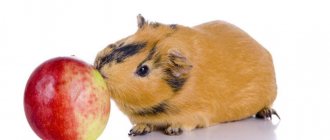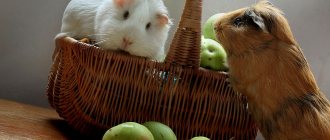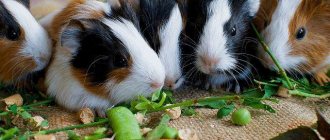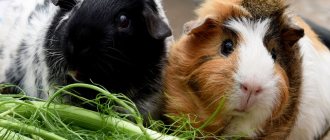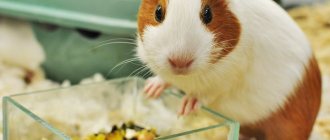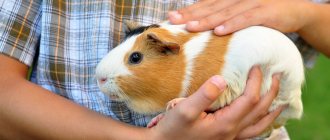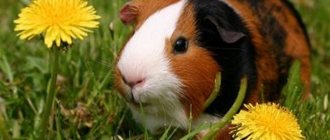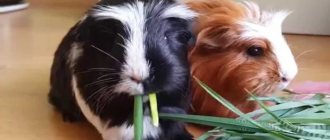Many people like to add a little variety to their guinea pig's diet by varying the fruits and vegetables they offer their pet in addition to the hay and dry guinea pig food or kibble that makes up the majority of their diet. Two foods that people may consider feeding their guinea pigs are grapes and raisins. So, are grapes and raisins safe for guinea pigs and do they add any nutritional value to their diet?
Can I give my guinea pig fresh grass?
Certainly! And not only is it possible, but it is necessary! In addition, fresh grass contains vitamin C, vitamins A and E, vitamin K and vitamin B6, which pigs need so much. ...
Interesting materials:
How to understand what unrequited love is? How do you understand what percentage is? How do you know when the pumpkin is ready? How do you know if a function is increasing or decreasing? How to understand GB of Internet? How to understand what kind of whitewash is on the ceiling? How to understand holofiber? How to understand a short participle or not? How to understand catch phrases? How to find a work?
“My puppy eats and everything is fine...”
On forums you can see many messages about a dog eating grapes and everything is fine. Entire theories have been put forward about the fact that you can give grapes “from the bush” - they are your own, domestic and safe, many dogs, according to the assurances of their owners, have been eating grapes for several years and everything is fine.
In general, there are many myths about the safety of grapes. Their creation was greatly facilitated by the fact that the nutritional composition of different grape varieties is very different and some of them may indeed be harmless to animals, but which ones have not yet been established.
It is important to remember two things: first, each animal's body is unique. Everyone has their own characteristics, their own diseases and threshold for assimilation of toxic substances
Secondly, the dog’s health depends entirely on you. According to statistics, in most cases this berry turns out to be poisonous, so is it worth the risk?
Fresh and dried, grown on a farm or even with your own hands, bought in a store, seedless grapes (you remember that it’s not the seeds), white and dark - all can equally turn out to be a lethal treat for a pet, leading to kidney failure .
Also, frequent consumption of grapes, even if everything went well the first time, can have a cumulative negative effect. In this case, the consequences of poisoning will appear in a couple of months. All of the above also applies to raisins: these are the same grapes, and the concentration of the substance in them is increased.
IMPORTANT: According to veterinarians, there are no substances in grapes that are beneficial for dogs. If an animal asks for it, this indicates exclusively a love for sweets.
But choosing a safe analogue of sweets will not be difficult.
Is it possible to give hamsters persimmons?
There is an opinion that you need to let the hamster try the product. If he eats it, then you can feed him. This approach is fundamentally wrong. Most hamsters will eat any food they can get their hands on.
In nature, they can even consume poisonous foods to their detriment. Therefore, before feeding your pet this or that fruit or vegetable, you should first find out whether this can be done and consult with an experienced specialist.
Persimmon should not be given to Djungarian hamsters Despite all the beneficial properties of persimmon, giving it to hamsters is strictly not recommended for several reasons:
- Persimmons contain a large amount of sugar, which is one of the main prohibitions in the diet of domestic hamsters. This is especially true for Dzungarian and Syrian species.
- Your hamster's diet should include foods that they eat in their natural habitat. Persimmon is not one of these fruits, as it grows in other regions.
- Persimmons contain quite a large amount of tannins. They directly affect the functioning of the digestive organs. If you look deeper, tannins are used to regulate and slow down intestinal motility.
Rules for natural nutrition
Regarding feeding the Pomeranian Spitz with natural food, there are general recommendations:
- Provide your dog with access to clean drinking water. Change it daily.
- Do not mix natural food and dry food. Choose one diet or give food at different times.
- If you decide to change your diet, you can’t do it right away. The shift period should take 2-3 weeks.
- Give only fresh food. If your pet doesn't eat enough food within 15 minutes, don't let him eat until the next meal.
- Determine the amount of food based on your pet's weight.
- The diet should be balanced. If you decide to feed your dog, consult your veterinarian for recommendations.
Dogs should not be given sweets.
Spitz can be given meat raw or slightly scalded, but only after preliminary freezing. Replace meat with offal two to three times a week.
Offal products that are an excellent addition to a natural diet include:
- scar;
- liver;
- lungs;
- kidneys;
- trachea.
By-products You can also give dogs low-fat sea fish, but not earlier than four months of age. This product should be given deboned, no more than once a week, completely replacing meat with fish.
Sour dairy products must be present in the diet. Their norm is no more than 30% of the daily food intake. For up to six months, your Spitz should be given cottage cheese every day. It is rich in calcium, which allows the formation of a healthy bone skeleton and cartilage tissue.
Add fermented milk to your diet about five times throughout the week.
The carbohydrate component is porridge, but not more than 15% of the total daily diet. You can feed buckwheat, rice, and oatmeal cooked in water or low-fat broth (no more than 2-3 times a week).
Suitable cereals for feeding
Egg yolks are responsible for the fat component. You can give quail eggs, but no more than 1-2 times a week in the amount of two or three pieces.
In hot weather, feed your dog once a day. During cold weather, distribute food evenly.
Pregnant and lactating bitches should not be hungry, so the food bowl does not need to be removed immediately after eating.
Feeding rules
The guinea pig is an ever-chewing animal, both during the day and at night. This is isolated by the physiological characteristics of rodents. Regular chewing prevents excessive tooth growth and improves digestion. Your pet needs to be provided with a properly balanced diet, an important component of which is succulent food.
When feeding fruits and berries, you should adhere to the following recommendations:
- feeding should be carried out at the same time so that the animals get used to the regime;
- all fruits and berries must be fresh and not heat-treated;
- fruits can be served 2-4 times every 7 days, and some exotic species - once a month;
- berries are given only as a treat;
- before feeding, the fruits are sorted, rotten and flabby ones are discarded, the rest are thoroughly washed, but not peeled;
- small affected areas of the fetus can be removed and the rest used for feeding;
- fruits that are in a pet’s cage for more than 6 hours should be thrown away;
- Apples and pears should be seeded and pitted, and bananas and citrus fruits should be peeled.
Using something tasty: a slice of apple or pear will help the owner get the guinea pig to communicate and get closer to the pet when they first meet.
Nutritional characteristics
They provide the body with essential nutrients.
The shell contains calcium, the egg white is good for the immune system and acts as a natural disinfectant, and the yolk is a source of essential nutrients. From the point of view of modern nutritional science, any eggs are close to the definition of an “ideal product.” The list of “ideal products” also included turtle eggs. This will surprise many, but the truth is that not only bird eggs are edible. Moreover, some call turtle product the king among all egg products available to humans.
This product has a better balance of nutrients than other types of eggs. They are small (from 2 cm in diameter and weighing from 5 g, although some weigh 35 g), perfectly round, with a whitish leathery shell. Many people note the product's external resemblance to ping pong balls. Each contains a white and a yolk. Compared to chicken or quail eggs, turtle eggs have a much larger yolk in relation to the white. Protein, compared to chicken protein, is more viscous and differs in chemical composition. In turtle products it consists mainly of the enzyme lysozyme. This substance, by the way, has disinfecting properties, it is useful for strengthening the immune system, and helps fight infections. But egg whites serve as more than just a source of nutrients. It is also designed to protect the yolk from bacteria.
Vegetable menu
The main task of vitamin C in the rodent body is to control the functioning of connective and bone tissues. Animals have to look for it from external sources, since the animal body is not able to produce it in such quantities.
Pigs' favorites on the menu most often include apples, carrots and cucumbers. Vitamin C can enter the animal’s body through raw food of plant origin.
It is important to give them to your pet at least 1 teaspoon per day
Veterinarians also list the following as approved products:
- Zucchini is allowed due to its high content of minerals and pectins, which normalize the functioning of intestinal permeability.
- Carrots have a positive effect on the condition of the animal’s coat and skin, as well as visual and auditory function. You can give not only the fruit itself, but also well-washed tops. Due to the content of Vitamin A, urine may turn orange.
- Bell pepper can be given to animals only during the season, due to the fact that winter varieties are oversaturated with nitrates. Only sweet varieties are allowed to serve as food.
- Pumpkin is also given to the animal almost completely. And zinc contained in the seeds is a strong preventative against helminthiases.
- Cucumbers themselves are low in calories, safe and have the ability to help digest heavy fats.
- Fresh peas are also acceptable, but in small quantities. Despite the disapproval of veterinarians. Some food manufacturers add the essence of the fruit to their mixtures, despite the fact that they can cause a negative side reaction in the animal.
- Cabbage is also allowed, but subject to proper supervision. While it causes gas in some people, excessive use can be dangerous for pigs. It is worth introducing it into the diet gradually, observing the reaction of your friend.
- Rutabaga facilitates bowel movements and helps avoid constipation. Best suited for your pet's winter diet.
- Jerusalem artichoke can be given as a treat, strictly limiting its total amount in the animal’s diet. The root vegetable itself is the most dangerous; other parts of the plant can be given constantly.
The most undesirable products include:
- Tomatoes are especially considered dangerous when green. They contain solanine, in addition, the use of tops is also not recommended. Ripe tomatoes, due to the destruction of poisons, can be included in the diet in small quantities. If you overdo it, the animal may experience intestinal upset and problems with the gastrointestinal tract.
- Potatoes are prohibited due to starch and solanine.
- Melon has a risk of developing diabetes due to the abundance of sugars.
- Radish and radish oils can cause bloating.
- Beetroot has a stable effect and is not particularly recommended for pregnant females. Root vegetables and tops are recommended for healthy individuals in small quantities. After eating beets, the animal’s urine may temporarily acquire a red tint.
- Corn is prohibited for pigs; only tops are allowed. And grains contain a large amount of starch, which can cause obesity.
What happens if a hamster eats a persimmon?
If you were in a hurry and decided to treat your pet to persimmons, be prepared for problems with the gastrointestinal tract.
First of all, carefully monitor the behavior and condition of your hamster. Any violation of habitual behavior signals that the animal has a problem. In severe cases, you should contact a veterinarian.
As we have already said, persimmon contains a large amount of tannins, and this can cause severe constipation in the animal or intestinal obstruction.
- Take a syringe without a needle.
- Take 1-2 ml of Vaseline oil and squirt it into your pet’s mouth. In extreme cases, you can use any vegetable or edible oil.
- Repeat after 20 minutes.
- Give a light abdominal massage, clockwise.
- If bowel movement does not occur within 4 hours, contact your veterinarian. The animal may have intestinal obstruction, which cannot be cured at home.
Also, the regular presence of persimmons in a hamster’s diet will lead to increased blood sugar levels and diabetes. This is a common problem with pet rodents.
You should not feed your Syrian hamsters persimmons. If your pet has eaten a small amount of persimmons, then it may not cause serious problems. First of all, you should provide the animal with plenty of fluids and not give food for several 5-12 hours.
Grapes with seeds or not?
Owners are often interested in the question: can a decorative rat be given sultanas? In fact, there is not much difference which grape is better. The presence of seeds will not harm your pet in any way. Typically, the list of prohibited foods for rodents includes pits of apricot, peach, plum, dogwood, cherry and sweet cherry. They contain a substance that is converted into hydrocyanic acid in the body.
But if we compare grape varieties with and without seeds, then, perhaps, the first option will be even more useful, since it usually contains less sucrose than the same sultanas.
To ensure that your rodent is always in a good mood and healthy, take care of its balanced diet. Sweets are something that rats will always eat with great pleasure, regardless of the nutritional value of the food. First of all, rodents focus on taste sensations.
Now you know that you can give grapes to rats, but it is very important not to feed the rodents sugary treats. After all, there should be a little bit of good.
Grain feed
A guinea pig needs to eat at least 20% grain per day. Grain food for rodents is sold in any pet store. The finished product usually includes:
- barley;
- oats;
- millet;
- sunflower seeds;
- corn grains.
In addition to grain, prepared feeds may include vegetable granules and vitamin supplements.
Dry pet food is easy to prepare yourself; you just need to buy different types of grains on the market and then mix them. But you need to take into account that the main ingredient is oats; guinea pigs eat it more readily than other grains. Solid grain food should always be present in the diet of rodents. Animals need it to grind down their continuously growing teeth. If a rodent eats only raw and soft food, then its incisors become unnaturally elongated and interfere with the ability to absorb food. As a result, the animal dies from starvation.
Quality grapes - what are they?
Many owners are very mistaken in believing that a decorative rat should and can eat absolutely everything. Including products that are far from fresh. When choosing grapes, you need to focus on fresh bunches. Rotten berries will bring neither benefit nor pleasure to a rodent. When choosing grapes, pay attention to their appearance.
Article on the topic: List of vegetables and fruits that can be given to guinea pigs
The best solution is to provide grapes grown in environmentally friendly conditions and without chemical treatment. Such berries can be collected at your summer cottage or bought from a small farmer at the market.
If wasps are constantly flying around a stand with grapes, this is an indication that it has not been treated with harmful chemicals. You can safely buy such berries. If you purchased them in a store, then before giving them to your pet, pour boiling water over them several times.
Banana
Can guinea pigs have bananas? Bananas contain a lot of vitamins and microelements. But this exotic fruit can be given occasionally in limited quantities, since due to the high sugar content in this fruit, problems with the rodent’s digestion may occur.
As for banana peels, you should not give them at all. After all, bananas are treated several times with chemicals for long-term storage. And just because your pet eats banana peels doesn't mean you can feed them to your guinea pig.
The benefits of succulent feed
Each plant is endowed with a set of useful substances, which determine its benefits for the rodent:
Snooze. It can be present in your pet’s summer diet every day. Improves digestion and enriches the body with vitamin C. It is especially useful in the spring, when you can pick young leaves of honeydew in the clearings. Red and white clover. Contains vitamins, proteins and essential oils, fiber. Give this herb in small portions no more than twice a week, and only on mature plants. It is contraindicated to give clover leaves to females who are carrying cubs due to the risk of miscarriage. Plantain is useful for rodents due to potassium, glycosides, enzymes, tannins, and vitamins. The rodent benefits from young leaves that are collected away from the highways. Quinoa. Contains many useful microelements. Benefits in small quantities
Because of oxalic acid, it is given with caution, no more than once every 2 weeks, so as not to provoke urolithiasis. Chamomile. Refers to medicinal products, removes inflammatory processes in the body, acts as an antispasmodic and sedative.
Fresh chamomile is given to pigs once a week as a preventive measure. Decoctions are effective for stomach disorders. Burdock. Improves metabolism, is a storehouse of vitamins and tannins. Pigs benefit from roots and young leaves in the spring-summer season. Sedge. Favorite grass of rodents with a rich composition of nutrients. In spring and summer you can include it in the animal’s daily diet. Spinach. Rich in proteins, vitamins and potassium. In spring, animals are given fresh leaves. They can be frozen for the winter. Dandelion. Only leaves can be given. As a vitamin spring green, it is simply irreplaceable. Cilantro. Rodents have ambivalent attitudes towards this spicy greenery, which contains a rich range of beneficial microelements and vitamins. Because of its specific taste and aroma, some pets love cilantro, while others don’t even touch it. Can be included in the diet all year round. Iceberg lettuce. Refers to winter types of salads and can accumulate pesticides that are dangerous for pets. If grown at home, it is useful to include it in the pig's diet 2 times a week. Arugula. Give the rodent a limited amount due to the concentration of mustard oil. Nitrates can accumulate in the leaves. Coltsfoot. It belongs to medicinal plants, so it is beneficial only in limited quantities. Useful for inflammatory processes of the gastrointestinal tract and colds. Wheatgrass. Can be given to your pet daily. Forms the basis for hay. Improves digestion, increases appetite. Common wormwood. Useful for rodents. They eat it with great eagerness. Not to be confused with wormwood, which blooms with yellow flowers. Alfalfa. Recommended for pregnant and lactating females and young animals. Due to the large amount of calcium, adult rodents are given limited amounts. Woodlouse. It belongs to medicinal plants, but has no contraindications as a daily food. Boosts immunity and improves digestion. Mint. The tasty and aromatic herb will bring many benefits to pigs if it is introduced into the diet in doses. The problem is that not all pets tolerate it. Lettuce leaves are good as winter greens. Give to pets without petioles to reduce the likelihood of nitrates entering the body.
Most pigs love celery, parsley, young apple tree leaves, and fresh hay made from a collection of meadow herbs.
Other products
Can guinea pigs eat bread? It's better not to give.
- Fresh yeast bread takes a long time to digest and causes fermentation in the animal’s stomach.
- White bread causes bloating.
- Your pet can eat stale bread, but not often.
- Dried bread with seeds, sesame seeds and raisins can sometimes be offered to your pet as a treat.
Can guinea pigs eat nuts and seeds?
Nuts and seeds are among the allowed foods, but can cause obesity if their consumption is not limited. It is better to offer your pet almonds, walnuts or hazelnuts.
The seeds contain many components useful for the animal: fatty acids, calcium, sodium, phosphorus, proteins and vitamins. It is better to give peeled seeds and make sure that they are no more than 15% of the total feed.
Article on the topic: Hay for guinea pigs: which is better, how to prepare and give

